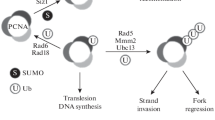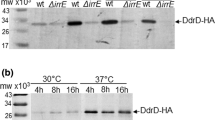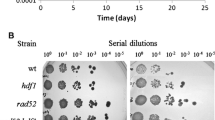Summary
In the yeast Saccharomyces cerevisiae the RAD2 gene is absolutely required for damage-specific incision of DNA during nucleotide excision repair and is inducible by DNA-damaging agents. In the present study we correlated sensitivity to killing by DNA-damaging agents with the deletion of previously defined specific promoter elements. Deletion of the element DRE2 increased the UV sensitivity of cells in both the G1/early S and S/G2 phases of the cell cycle as well as in stationary phase. On the other hand, increased UV sensitivity associated with deletion of the sequence-related element DRE1 was restricted to cells irradiated in G1/S. Specific binding of protein(s) to the promoter elements DRE1 and DRE2 was observed under non-inducing conditions using gel retardation assays. Exposure of cells to DNA-damaging agents resulted in increased protein binding that was dependent on de novo protein synthesis.
Similar content being viewed by others
References
Arcangioli B, Lescure B (1985) Identification of proteins involved in the regulation of yeast iso-1-cytochrome C expression by oxygen. EMBO J 4:2627–2633
Berk AJ, Schmidt MC (1990) How do transcription factors work? Genes Dev 4:151–155
Bradford M (1976) A rapid and sensitive method for the quantitation of microgram quantities of protein utilizing the principle of protein-dye binding. Anal Biochem 72:248–254
Cole GM, Mortimer RK (1989) Failure to induce a DNA repair gene, RAD54, in Saccharomyces cerevisiae does not affect DNA repair or recombination pathways. Mol Cell Biol 9:3314–3322
Cole GM, Schild D, Lovett ST, Mortimer RK (1987) Regulation of RAD54- and RAD52-lacZ gene fusions in Saccharomyces cerevisiae in response to DNA damage. Mol Cell Biol 7:1078–1084
Demple B, Greenberg JT, Johnson A, Levin JD (1989) Cellular defenses against oxidative damage: roles of inducible resistance in bacteria and a widespread DNA repair system for oxidative strand breaks. In: Friedberg EC, Hanawalt PC (eds) Mechanisms and consequences of DNA damage processing. AR Liss, New York, pp 159–166
DiDomenico BJ, Bugaisky GE, Lindquist S (1982) The heat-shock response is self-regulated at both the transcriptional and post-transcriptional level. Cell 31:593–603
Elledge SJ, Davis RW (1987) Identification and isolation of the gene encoding the small subunit of ribonucleotide reductase from Saccharomyces cerevisiae: DNA damage-inducible gene required for mitotic viability. Mol Cell Biol 7:2783–2793
Elledge SJ, Davis RW (1989a) Identification of the DNA damage-responsive element of RNR2 and evidence that four distinct cellular factors bind. Mol Cell Biol 9:5373–5386
Elledge SJ, Davis RW (1989b) DNA damage induction of ribonucleotide reductase. Mol Cell Biol 9:4932–4940
Elledge SJ, Davis RW (1990) Two genes differentially regulated in the cell cycle and by DNA-damaging agents encode alternative regulatory subunits of ribonucleotide reductase. Genes Dev 4:740–751
Friedberg EC (1988) Deoxyribonucleic acid repair in the yeast Saccharomyces cerevisiae. Microbiol Rev 52:70–102
Friedberg EC, Siede W, Cooper AJ (1991) Cellular responses to DNA damage in yeast. In: Jones E, Pringle JR, Broach J (eds) The molecular and cellular biology of the yeast Saccharomyces, vol I. Genome dynamics, protein synthesis, and energetics. Cold Spring Harbor Laboratory Press, Cold Spring Harbor, New York, pp 147–191
Hurd HK, Roberts JW (1989) Upstream regulatory sequences of the yeast RNR2 gene include a repression sequence and an activation site that binds the RAP1 protein. Mol Cell Biol 9:5359–5372
Johnston LH, White JHM, Johnson AL, Lucchini G, Plevani P (1987) The yeast DNA polymerase I transcript is regulated in both the mitotic cell cycle and in meiosis and is also induced after DNA damage. Nucleic Acids Res 15:5017–5030
Jones JS, Prakash L (1991) Transcript levels of the Saccharomyces cerevisiae DNA repair gene RAD18 increase in UV irradiated cells and during meiosis but not during the mitotic cell cycle. Nucleic Acids Res 19:893–898
Jones JS, Prakash L, Prakash S (1990) Regulated expression of the Saccharomyces cerevisiae DNA repair gene RAD7 in response to DNA damage and during sporulation. Nucleic Acids Res 18:3281–3285
Krämer M, Stein B, Mai S, Kunz E, König H, Loferer H, Grunicke HH, Ponta H, Herrlich P, Rahmsdorf HJ (1990) Radiation-induced activation of transcription factors in mammalian cells. Radiat Environ Biophys 29:303–313
Lindahl T, Sedgwick B, Sekiguchi M, Nakabeppu Y (1988) Regulation and expression of the adaptive response to alkylating agents. Annu Rev Biochem 57:133–157
Lücke-Huhle C, Mai S, Herrlich P (1989) UV-induced early-domain binding factor as the limiting component of Simian Virus 40 DNA amplification in rodent cells. Mol Cell Biol 9:4812–4818
Madura K, Prakash S (1986) Nucleotide sequence, transcript mapping, and regulation of the RAD2 gene of Saccharomyces cerevisiae. J Bacteriol 166:914–923
Madura K, Prakash S (1990) Transcript levels of the Saccharomyces cerevisiae DNA repair gene RAD23 increase in response to UV light and in meiosis but remain constant in the mitotic cell cycle. Nucleic Acids Res 18:4737–4742
Madura K, Prakash S, Prakash L (1990) Expression of the Saccharomyces cerevisiae DNA repair gene RAD6 that encodes a ubiquitin conjugating enzyme, increases in response to DNA damage and in meiosis but remains constant during the mitotic cell cycle. Nucleic Acids Res 18:771–778
McClanahan T, McEntee K (1984) Specific transcripts are elevated in Saccharomyces cerevisiae in response to DNA damage. Mol Cell Biol 4:2356–2363
Perozzi G, Prakash S (1986) RAD7 gene of Saccharomyces cerevisiae: transcripts, nucleotide sequence analysis and functional relationship between RAD7 and RAD23 gene product. Mol Cell Biol 6:1497–1507
Peterson TA, Prakash L, Prakash S, Osley MA, Reed SI (1985) Regulation of CDC9, the Saccharomyces cerevisiae gene that encodes DNA ligase. Mol Cell Biol 5:226–235
Pfeifer K, Arcangioli B, Guarente L (1987) Yeast HAP1 activator competes with the factor RC2 for binding of the upstream activation site UAS1 of the CYC1 gene. Cell 49:9–18
Ptashne M (1986) Gene regulation by proteins acting nearby and at a distance. Nature 322:697–701
Rahmsdorf HJ, Harth N, Eades A-M, Litfin M, Steinmetz M, Form L, Herrlich P (1986) Interferon-γ, mitomycin C, and cycloheximide as regulatory agents of MHC class II-associated invariant chain expression. J Immunol 136:2293–2299
Rahmsdorf HJ, Schönthal A, Litfin M, Rüther U, Herrlich P (1987) Posttranscriptional regulation of c-fos mRNA expression. Nucleic Acids Res 15:1643–1659
Robinson GW, Nicolet CM, Kalainov D, Friedberg EC (1986) A yeast excision repair gene is inducible by DNA damaging agents. Proc Natl Acad Sci USA 83:1842–1846
Rothstein RJ (1983) One-step gene disruption in yeast. Methods Enzymol 101:202–211
Ruby SW, Szostak JW (1985) Specific Saccharomyces cerevisiae genes are expressed in response to DNA-damaging agents. Mol Cell Biol 5:75–84
Sambrook J, Fritsch EF, Maniatis T (1990) Molecular cloning — A laboratory manual. Cold Spring Harbor Laboratory Press, Cold Spring Harbor, New York
Sancar GB (1985) Sequence of Saccharomyces cerevisiae PHR1 gene and homology of the PHR1 photolyase to E. coli photolyase. Nucleic Acids Res 13:8231–8246
Sancar GB, Smith FW (1989) Interactions between yeast photolyase and nucleotide excision repair proteins in Saccharomyces and E. coli. Mol Cell Biol 9:4767–4776
Sebastian S, Kraus B, Sancar GB (1990) Expression of the yeast PHR1 gene is induced by DNA-damaging agents. Mol Cell Biol 10:4630–4637
Siede W, Friedberg EC (1990) Influence of DNA repair deficiencies on the UV sensitivity of yeast cells in different cell cycle stages. Mutat Res 245:287–292
Siede W, Robinson GW, Kalainov D, Malley T, Friedberg EC (1989) Regulation of the RAD2 gene of Saccharomyces cerevisiae. Mol Microbiol 3:1697–1707
Singh H, Clerc RG, LeBowitz JH (1989) Molecular cloning of sequence-specific DNA binding proteins using recognition site probes. BioTechniques 7:252–261
Sousa R, Arcangioli B (1989) A point mutation in the CYC1 UAS creates a new combination of regulatory elements that activate transcription synergistically. EMBO J 8:1801–1808
Stein B, Rahmsdorf HJ, Steffen A, Litfin M, Herrlich P (1989) UV-induced DNA damage is an intermediate step in UV-induced expression of human immunodeficiency virus type 1, collagenase, c-fos, and metallothionein. Mol Cell Biol 9:5169–5181
Theodorakis NG, Morimoto RI (1987) Posttranscriptional regulation of hsp70 expression in human cells: effects of heat shock, inhibition of protein synthesis, and adenovirus infection on translation and mRNA stability. Mol Cell Biol 7:4357–4368
Treger JM, Heichman KA, McEntee K (1988) Expression of the yeast UBI4 gene increases in response to DNA-damaging agents and in meiosis. Mol Cell Biol 8:1132–1136
Walker GC (1984) Mutagenesis and inducible responses to deoxyribonucleic acid damage in Escherichia coli. Microbiol Rev 48:60–93
Winter E, Varshavsky A (1989) A DNA binding protein that recognizes oligo(dA)-oligo(dT) tracts. EMBO J 8:1867–1877
Yagle K, McEntee K (1990) The DNA damage-inducible gene DIN1 of Saccharomyces cerevisiae encodes a regulatory subunit of ribonucleotide reductase and is identical to RNR3. Mol Cell Biol 10:5553–5557
Zimarino V, Tsai C, Wu C (1990) Complex modes of heat shock factor activation. Mol Cell Biol 10:752–759
Author information
Authors and Affiliations
Additional information
Communicated by R. Devoret
Rights and permissions
About this article
Cite this article
Siede, W., Friedberg, E.C. Regulation of the yeast RAD2 gene DNA damage-dependent induction correlates with protein binding to regulatory sequences and their deletion influences survival. Molec. Gen. Genet. 232, 247–256 (1992). https://doi.org/10.1007/BF00280003
Received:
Issue Date:
DOI: https://doi.org/10.1007/BF00280003




